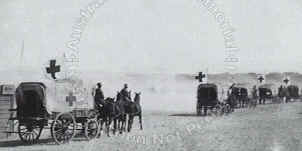|
The Australian Light Horse units were mounted
infantry. They were not a force of cavalry, in that it was never
intended that they should fight on horseback. Indeed, one of the most
memorable battles of World War One, the charge of the Light Horse at Beersheba
was quite unusual.
In general, Light Horse units would be sent to
key positions in the forward line, where they would dismounted, and then
fight.
| One important element in the success of the
light horse was efficient, highly mobile medical support. Unlike mounted
units in the British and other Dominion armies, the primary medical
personnel of the light horse were mounted. They ensured the removal of
the wounded from the front line or regimental aid posts to the advanced
dressing station, at which there were surgical and resting tents. |
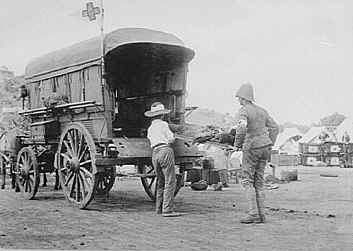 |
In the early stages of the Sinai and Palestine
campaigns, sand-carts and camels were used to evacuate men from the
lines of battle.
However, each were found to be inefficient means of
moving the wounded. The sand carts were adaptations of a design that had
long been in use in upper Egypt and Sinai. They had two wheels with
tyres that were wide enough to stop the cart digging into soft sand, and
could carry two or three stretchers.
However, in heavy sand it was that
four horses were necessary to pull the cart, and that the cart had to be
steered by a rider on one of the lead horses. In times of emergency,
many more than three men had to be speedily evacuated, making the sand
cart liable to become bogged or hard to steer.
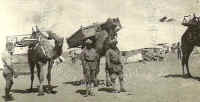 |
Camels were also used. Two wounded were
strapped into a horizontal platform suspended from either side of the
camel's saddle, with their heads facing that of the camel. Early
versions of these platforms were little better than boxes rigidly joined
together which, in the words of the official historian of the Australian
army medical services, were '...perhaps the most uncomfortable form of
wounded transport ever devised.' |
The design was improved after similar
devices used by Turkish medical units were captured after the battle of
Romani. However, no matter comfortable the resting position of the
wounded was made, the fact remained that they were strapped to a camel,
an animal which walks with a slow and swaying gate.
| Pte. G.H. Blyth, 2nd Light Horse
Field Ambulance, wearing full equipment, photographed on board a
transport on 1915-10-04. (donated by Captain J.D. Cramb.) |
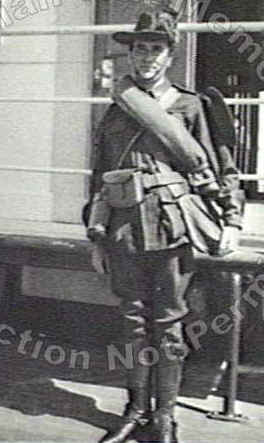 |
When the weights of
the men on either side of the camel were unequal, the device sagged, and
as the camel sought to keep upright and moving forwards, the movement of
the platforms were made even more unpleasant. It was not uncommon for
the wounded to suffer motion sickness, which in the case of the severely
wounded was sometime fatal.
| Camels were slow, moving on average only two
and half miles an hour. They also attracted flies which could spread
bacteria from the camel's digestive tract to hastily dressed wounds.
Further, camels, especially those heavily loaded and some time without
water could be ill-tempered and ready to inflict what could be quite
savage bites. |
 |
Given the shortcomings of sand-carts and
camels, medical personnel were quick explore other modes of conveying
the wounded to field ambulances. They soon came to realise that the best
form of conveyance would be a sledge, constructed in much the same way
as those traditionally used by the nomadic peoples of the Sinai region.
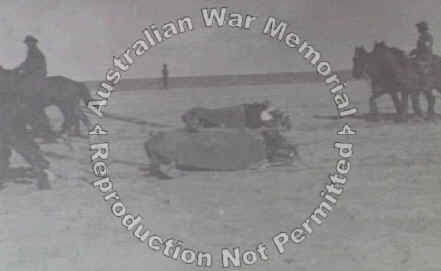 |
Sand sleds (sledges) being used to
move the wounded, Palestine |
Sledges had the advantage of being able to be pulled by one horse, at
reasonable speed, and with much less discomfort to the wounded. However,
absence of ready materials for sledges meant that light horse ambulances
continued to use a mixture of sand-carts, camel platforms and sledges to
evacuate the wounded, often reserving the sledges for the transport of
the most severe cases. |

